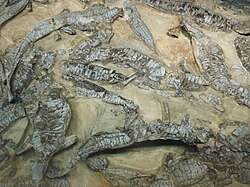Aetosaur
Aetosaurs were heavily armoured reptiles in the extinct order Aetosauria. They were medium- to large-sized pseudosuchians. They were omnivorous or herbivorous
| Aetosauria Temporal range: Upper Triassic, 231.4–201.3
| |
|---|---|

| |
| Skeletal mount of Desmatosuchus | |
| Scientific classification | |
| Kingdom: | Animalia |
| Phylum: | Chordata |
| Class: | Reptilia |
| Clade: | Aetosauriformes |
| Order: | Aetosauria Lydekker, 1887 |
| Subgroups | |
| |
The aetosaurs were archosaurs more closely related to crocodilians than to dinosaurs. All known aetosaurs lived in the Upper Triassic. In some strata they are quite common.
They had small heads, upturned snouts, erect limbs, and a body ornamented with four rows of plate-like osteoderms (bony scutes). Aetosaur fossil remains are found in Europe, North and South America, parts of Africa, and India.
Since their armoured plates are often preserved and are common in certain places, aetosaurs serve as important Upper Triassic tetrapod index fossils. Many aetosaurs had wide geographic ranges, but they did not survive long. Their stratigraphic ranges were short. Therefore, the presence of particular aetosaurs accurately dates the site where they are found.[1][2]
Over 20 genera of aetosaurs have been described. Two distinct subdivisions of aetosaurs are currently recognized, Desmatosuchia and Aetosaurinae, based primarily on broad differences in skull morphology. Osteoderms structure is generally one of the most useful traits for classification. Among other archosaurs, aetosaurs are most closely related to Revueltosaurus, a small reptile whose teeth were once mistaken for those of a herbivorous dinosaur.
Aetosaur Media
Aetosaur skull reconstructions: (A) Aetosaurus ferratus, (B) Paratypothorax andressorum, (C) Stagonolepis robertsoni, (D) Desmatosuchus smalli, (E) Aetosauroides scagliai
Life restoration and size diagram of Desmatosuchus spurensis
Life restoration of Typothorax coccinarum
The articulated skeletons of 22 Aetosaurus, discovered near Stuttgart, Germany and first described by Oskar Fraas in 1877. The skeletons are now in the State Museum of Natural History Stuttgart.
Photograph of the carapace of Stegomus, described by Marsh in 1896
Aetosaur body fossils have been found in North America, South America, Europe, and parts of Asia and Africa.
References
- ↑ Heckert, A.B.; Lucas S.G. (2002). "South American occurrences of the Adamanian (Late Triassic: Latest Carnian) index taxon Stagonolepis (Archosauria: Aetosauria) and their biochronological significance". Journal of Paleontology. 76 (5): 852–863. doi:10.1666/0022-3360(2002)076<0852:SAOOTA>2.0.CO;2. ISSN 0022-3360. S2CID 128610620. Archived from the original on 2023-10-05. Retrieved 2022-07-29.
- ↑ Lucas, S. G. (1998). "Global Triassic tetrapod biostratigraphy and biochronology". Palaeogeography, Palaeoclimatology, Palaeoecology. 143 (4): 347–384. Bibcode:1998PPP...143..347L. CiteSeerX 10.1.1.572.872. doi:10.1016/S0031-0182(98)00117-5.








